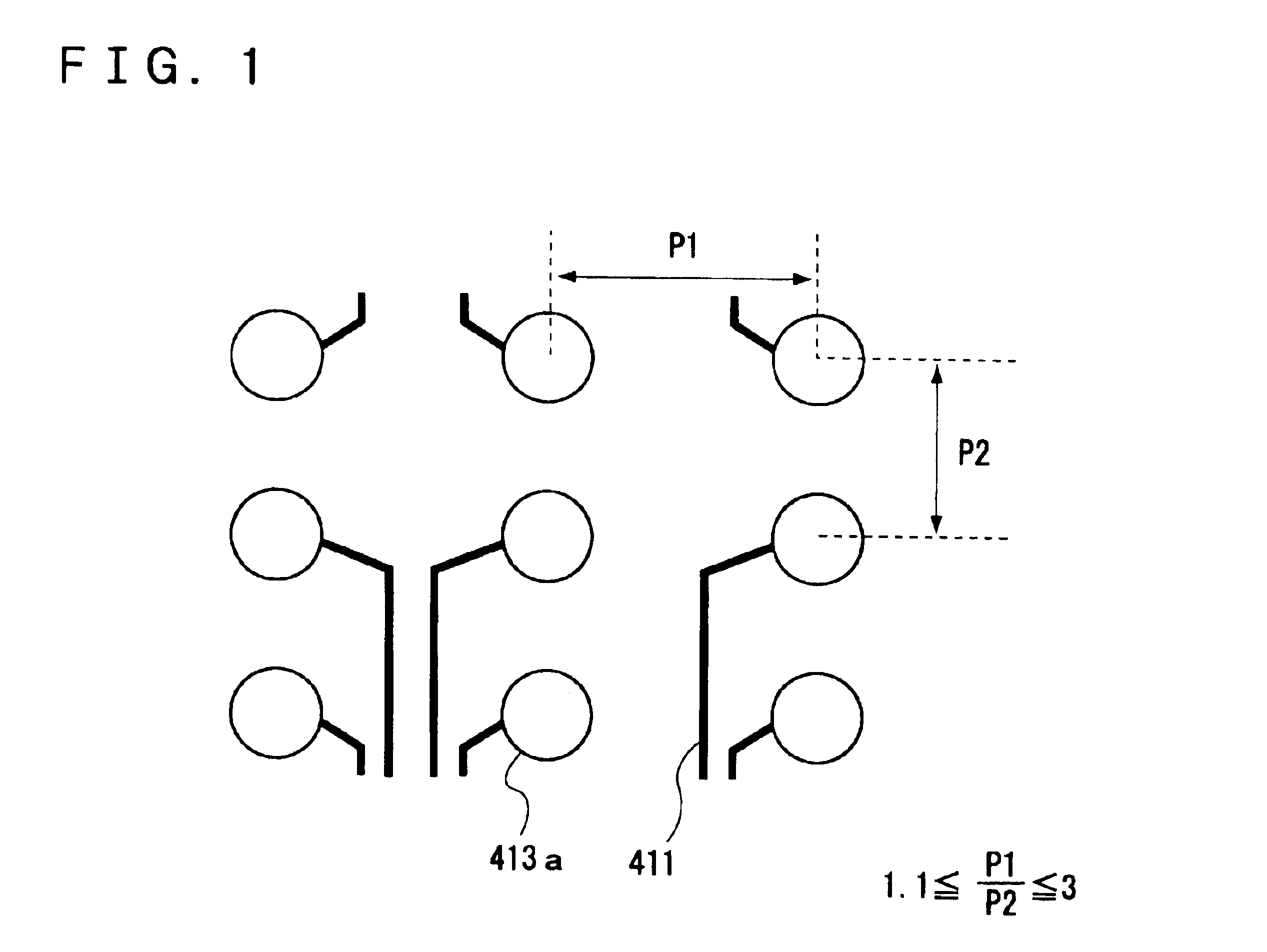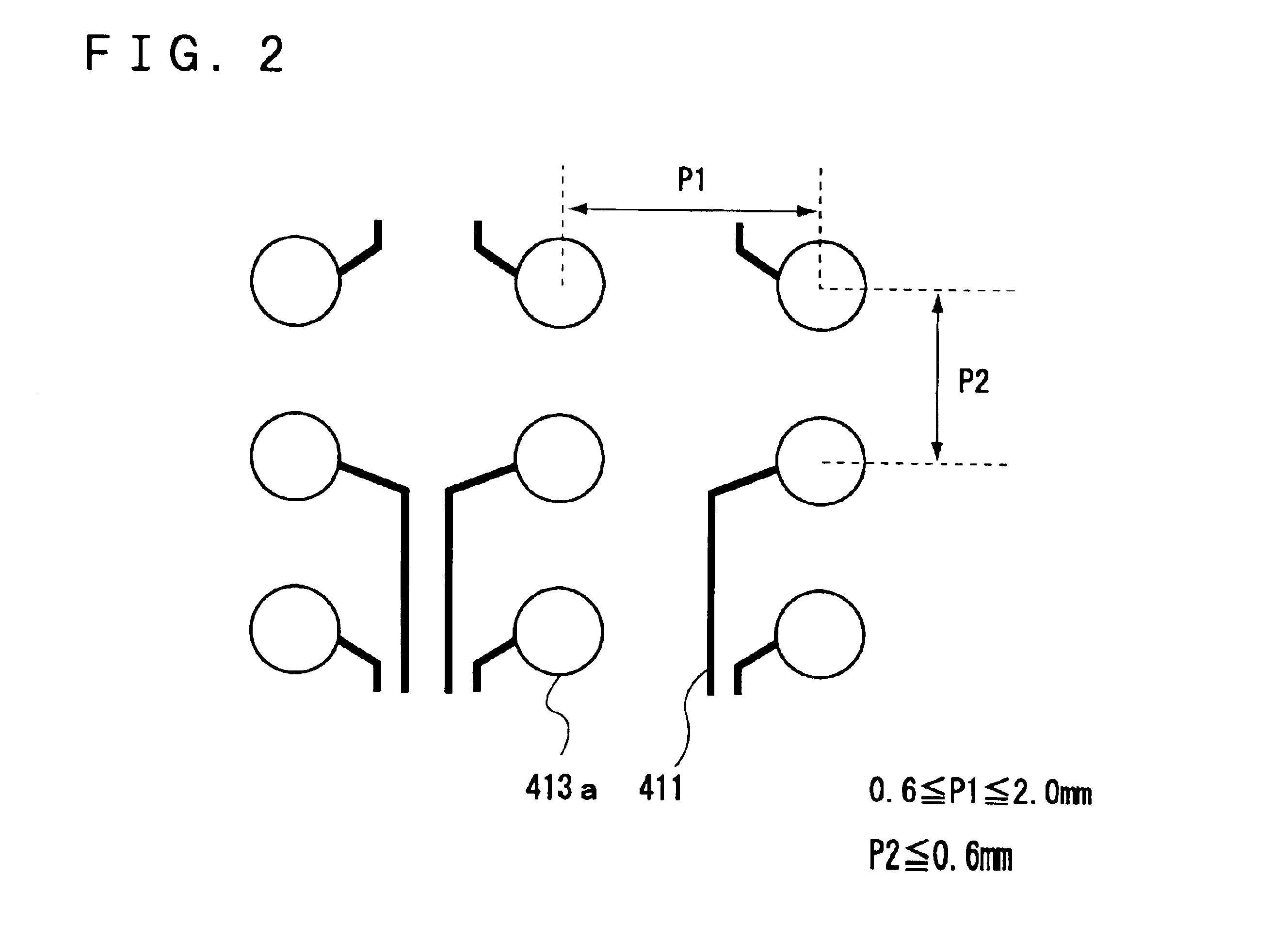Circuit board, mounting structure for semiconductor device with bumps, and electro-optic device and electronic device
a technology for semiconductor devices and mounting structures, applied in the direction of printed circuit non-printed electric components association, sustainable manufacturing/processing, final product manufacturing, etc., can solve the problems of easy displacement of the position of printed solder material and the pad, low connection reliability of qfp, etc., and achieve less occurrence of short circuits and high environmental stability
- Summary
- Abstract
- Description
- Claims
- Application Information
AI Technical Summary
Benefits of technology
Problems solved by technology
Method used
Image
Examples
first embodiment
Referring to FIG. 1, a first embodiment is a circuit board including a plurality of pads 413a for mounting a semiconductor device with bumps and a plurality of wires 411 drawn from the plurality of pads 413a, the circuit board including a region where the pitch in the longitudinal direction and the lateral direction of the pads 413a are different, and the wires 411 being preferentially drawn from a wider pitch side of the longitudinal direction or the lateral direction of the pads 413a.
1. Pad
(1) Anisotropy
1) Ratio of Pitches
It is preferable to set the ratio P1 / P2 within the range of 1.01 to 3 where P1 is a wider pitch of the pads and P2 is a narrower pitch.
This is because when the ratio P1 / P2 becomes less than 1.01, it may be difficult to draw the wires to the exterior and to route them. On the other hand, when the ratio P1 / P2 has exceeded 3, the number of pads that can be arranged in unit area may be excessively limited, or adversely it becomes difficult to route the wires.
Therefo...
second embodiment
Referring to FIG. 15, a second embodiment is a mounting structure for a semiconductor device with bumps, characterized in that a semiconductor device with bumps is mounted to a circuit board via a solder material applied on pads, the circuit board including a region where the pitch in the longitudinal direction and the lateral direction of the pads are different from each other, in which the wires of the pads are preferentially drawn from a wider pitch side of the longitudinal direction or the lateral direction.
Points similar to those of the first embodiment will be omitted as appropriate and characteristic points of the second embodiment will be described hereinafter with particular emphasis thereon.
1. Structure
(1) Basic Structure
A mounting structure 360 for the semiconductor device with bumps according to the second embodiment basically includes the semiconductor device (interposer) 63 with bumps, a circuit board 361, and a solder material 365, as shown in FIG. 15. Since the semic...
third embodiment
A third embodiment is an electro-optic device characterized by including a semiconductor device with bumps mounted on a circuit board having a region where the pitch in the longitudinal direction and the lateral direction of the pads are different from each other as a driving element or a power-supply element, in which the wires of the pads are preferentially drawn from a wider pitch side of the longitudinal direction or the lateral direction.
A liquid crystal panel that forms an electro-optic device shown in FIG. 21 will be described as an example.
Referring to FIG. 22, the schematic structure of a liquid crystal panel 200 in FIG. 21 will first be described. FIG. 22 schematically shows the state of the liquid crystal panel 200 of FIG. 21 before a semiconductor IC and a flexible wiring board are mounted thereon. In the drawing, the dimensions are adjusted for convenience in the drawing and select components are omitted as appropriate.
The liquid crystal panel 200 includes a color filte...
PUM
 Login to View More
Login to View More Abstract
Description
Claims
Application Information
 Login to View More
Login to View More - R&D
- Intellectual Property
- Life Sciences
- Materials
- Tech Scout
- Unparalleled Data Quality
- Higher Quality Content
- 60% Fewer Hallucinations
Browse by: Latest US Patents, China's latest patents, Technical Efficacy Thesaurus, Application Domain, Technology Topic, Popular Technical Reports.
© 2025 PatSnap. All rights reserved.Legal|Privacy policy|Modern Slavery Act Transparency Statement|Sitemap|About US| Contact US: help@patsnap.com



